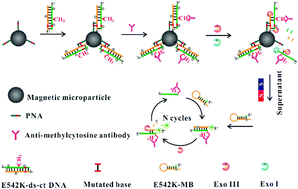Dual-recognition-based determination of ctDNA via the clamping function of peptide nucleic acid and terminal protection of small-molecule-linked DNA†
Abstract
A new dual-recognition fluorescent biosensor for circulating tumor DNA (ctDNA) detection has been developed, which combines the clamping function of peptide nucleic acid (PNA) and terminal protection of small-molecule-linked DNA (TPSMLD). Taking the tumor-specific E542K mutation and methylation of the PIK3CA gene as the target ctDNA, a low detection limit of 0.3161 pM ctDNA is achieved with good selectivity. This study not only offers a sensitive, selective and accurate ctDNA detection method, but can also be used to detect the target in complex biological samples.

- This article is part of the themed collection: Analyst Recent HOT articles


 Please wait while we load your content...
Please wait while we load your content...